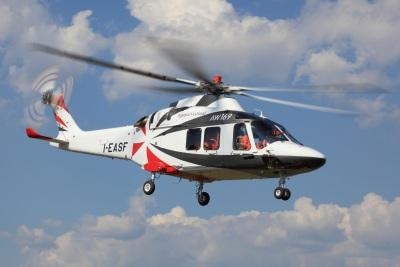Mon, Dec 15, 2014
The Contract Marks The Entrance Of The Type Into The Italian Passenger Transport Market With Delivery In Mid-2015
HoverFly of Italy has signed a contract for an AW169 light intermediate twin engine helicopter to perform passenger transport missions plus a comprehensive package of support and training services. This aircraft will replace an aging AS365 helicopter providing the operator with greater mission capability and the latest safety features. The AW169 is scheduled to be delivered in mid-2015 and will operate from HoverFly’s base near Rome.

This contract marks the entrance of the all new AW169 helicopter into the Italian passenger transport market and further expands the success of the type in Italy, where it has already achieved significant success for other roles such as emergency medical service (EMS). Success of the AW169 in the passenger transport and VIP/corporate market has been steadily growing as the aircraft nears certification, particularly in South American and European markets.
The AW169 incorporates several new technology features in the rotor system, engines, avionics, transmission and electric power generation and distribution systems, and is the first all new helicopter in its class in more than 30 years. The AW169 can accommodate up to ten passengers. Auxiliary power unit (APU) mode ensures the continued operation of the environmental control system, radios and medical devices when the rotors are stopped.
The AW169’s avionic suite introduces state-of-the-art technology including a full digital NVG compatible cockpit with three 8” x 10” large area displays (AMLCD) and touch screen technology with enhanced graphics capability for maximum situational awareness. A 4-axis digital automatic flight control system (DAFCS) with dual Flight Management System (FMS) minimises crew workload allowing single/dual pilot VFR/IFR operations. The avionics suite also complies with satellite-based navigation, communication and surveillance requirements and has the capability to perform satellite-based IFR LPV (localizer performance with vertical guidance) approaches to maximize round-the-clock utilisation of the helicopter. Safety enhancing avionics such as Terrain Awareness Warning Systems, airborne collision avoidance systems can be added to the standard avionic configuration.
The AW169 is designed with inherent ease of maintenance, for reliable, intensive utilization in the most demanding conditions with high time between overhauls (TBO) and minimal life-limited parts. Time between successive inspections has been optimized to maximize aircraft availability and reduce maintenance man hours per flight hour, adopting MSG-3 approach for the maintenance process. Maintenance programs can be tailored to meet operators’ specific requirements. Comprehensive, advanced training programs for maintenance technicians and flight crews are available including training on a level-D full flight simulator to enhance safety and mission effectiveness.
The AW169 helicopter is part of AgustaWestland’s family of new generation helicopters that also includes the AW139 and AW189. Over 120 AW169 helicopters have now been ordered by customers around the world.
(AW169 pictured in file photo)
More News
Terminal Radar Service Area Airspace surrounding designated airports wherein ATC provides radar vectoring, sequencing, and separation on a full-time basis for all IFR and participa>[...]
Aero Linx: Utah Back Country Pilots Association (UBCP) Through the sharing experiences, the UBCP has built upon a foundation of safe operating practices in some of the most challen>[...]
From 2010 (YouTube Edition): Imagine... Be The Change... Inspire FROM 2010: One of the more unusual phone calls I have ever received occurred a few years ago... from Anousheh Ansar>[...]
(Pilot) Felt A Shudder And Heard The Engine Sounding Differently, Followed By The Engine Chip Detector Light On April 14, 2025, about 1800 Pacific daylight time, a Bell 206B, N1667>[...]
Also: AMA Names Tyler Dobbs, More Falcon 9 Ops, Firefly Launch Unsuccessful, Autonomous F-16s The Air Force has begun ground testing a future uncrewed jet design in a milestone tow>[...]
 ANN's Daily Aero-Term (05.07.25): Terminal Radar Service Area
ANN's Daily Aero-Term (05.07.25): Terminal Radar Service Area ANN's Daily Aero-Linx (05.07.25)
ANN's Daily Aero-Linx (05.07.25) Classic Aero-TV: Anousheh Ansari -- The Woman Behind The Prize
Classic Aero-TV: Anousheh Ansari -- The Woman Behind The Prize NTSB Prelim: Bell 206B
NTSB Prelim: Bell 206B Airborne-NextGen 05.06.25: AF Uncrewed Fighters, Drones v Planes, Joby Crew Test
Airborne-NextGen 05.06.25: AF Uncrewed Fighters, Drones v Planes, Joby Crew Test



